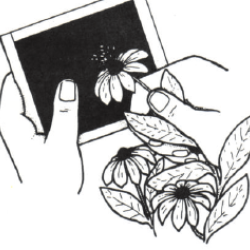Source Institutions
Source Institutions
Add to list Go to activity
Activity link broken? See if it's at the internet archive

In this outdoor activity, learners use artificial bees and paper models of flowers to find out how bees transfer pollen from one flower to another. Background information discusses bees and other pollinators such as hummingbirds and butterflies, and describes the way bees move pollen around. Learners use pollen boards to pick up pollen from real flowers, make paper flowers to learn how real flowers are structured, use model flowers and artificial bees to act out bees visiting flowers for pollen, and use artificial bees to collect real pollen. Learners are asked to consider other kinds of pollination (wind, water or larger animals) and the impact on pollination when bees are killed with insect poison.
- 1 to 2 hours
- 45 to 60 minutes
- $10 - $20 per group of students
- Ages 8 - 14
- Activity, Lesson/Lesson Plan, Model, Simulation
- English
Quick Guide
Materials List (per group of students)
- paper flower shapes: dish, cone and 3-oz. paper cups
- Flower Shapes card (page 6 of PDF)
- magnifying lens
- pieces of flagging each about 30 cm long
- zip-lock bag
- Flower-Powder Junk Box with tape,cotton swabs, pipe cleaners, yarn, glue, popsicle sticks, etc.
- scissors
- 3 small containers of pretend pollen (cornstarch and 2 colors tempera paint
- Pollen Collectors' equipment card (page 5 of PDF)
- cardboard pieces (10 cm x 15 cm)
- pieces of black velveteen or corduroy (10 cm x 15 cm)
- masking tape
- 4-6 cm pieces of black pipe cleaner (chenille)
- white paper
- black felt pen
- rubber cement
Subjects
-
Life Sciences
-
Diversity of Life
- Plants
- Animals
-
Ecology
- Ecosystems
- Human Impact
-
Evolution
- Evidence for Evolution
-
Diversity of Life
-
The Nature of Science
-
The Scientific Process
- Asking Questions
- Conducting Investigations
- Gathering Data
- Formulating Explanations
- Communicating Results
-
The Scientific Process
Informal Categories
- Animals
- Arts and Crafts
- Gardening
- Model Building
- Nature and Environment
- Outdoor Activity
Audience
To use this activity, learners need to:
- see
- see color
- be mobile
- touch
Learning styles supported:
- Involves teamwork and communication skills
- Involves hands-on or lab activities
Other
This resource is part of:
Access Rights:
- Free access
By:
Rights:
- All rights reserved, The Regents of the University of California, 1979
